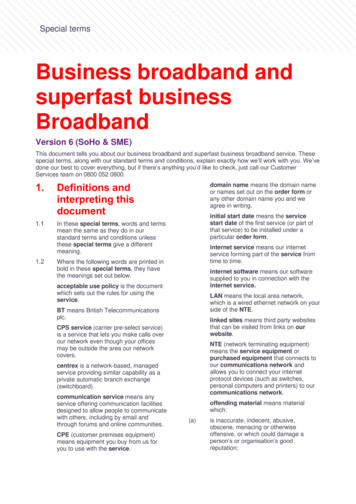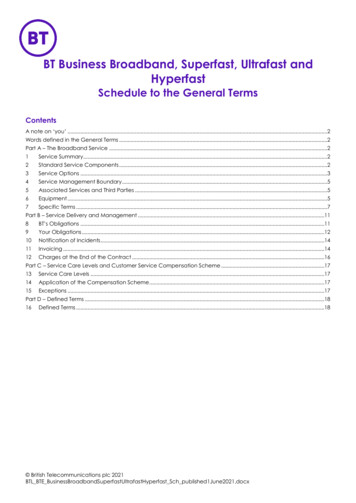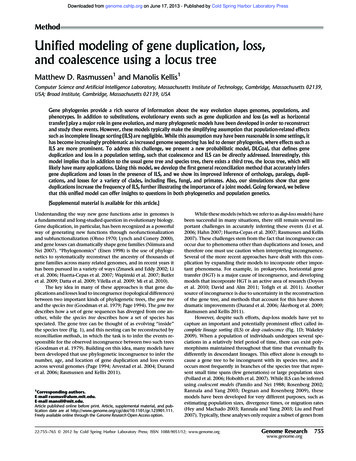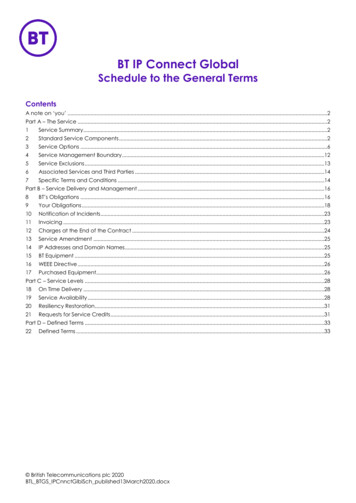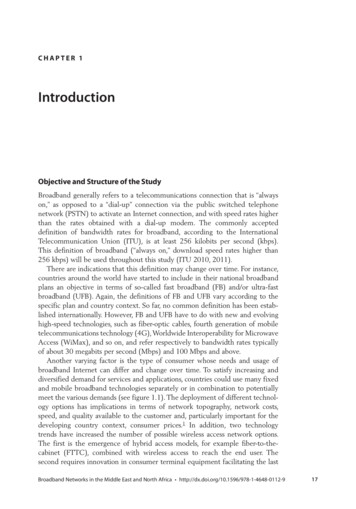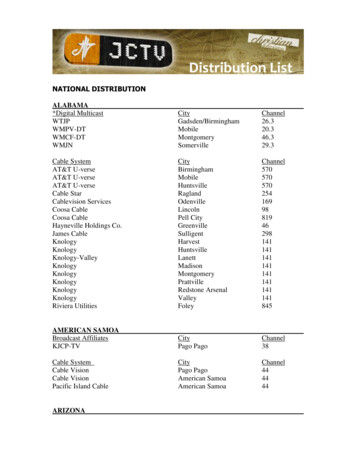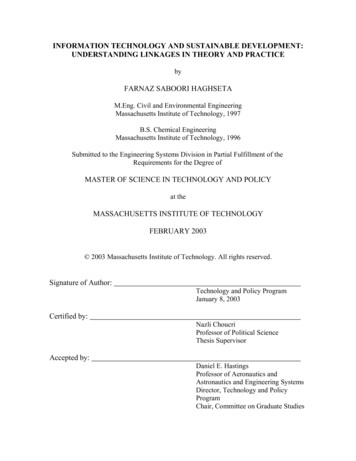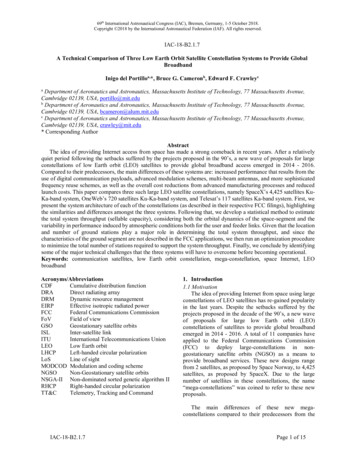
Transcription
69th International Astronautical Congress (IAC), Bremen, Germany, 1-5 October 2018.Copyright 2018 by the International Astronautical Federation (IAF). All rights reserved.IAC-18-B2.1.7A Technical Comparison of Three Low Earth Orbit Satellite Constellation Systems to Provide GlobalBroadbandInigo del Portilloa,*, Bruce G. Cameronb, Edward F. CrawleycaDepartment of Aeronautics and Astronautics, Massachusetts Institute of Technology, 77 Massachusetts Avenue,Cambridge 02139, USA, portillo@mit.edubDepartment of Aeronautics and Astronautics, Massachusetts Institute of Technology, 77 Massachusetts Avenue,Cambridge 02139, USA, bcameron@alum.mit.educDepartment of Aeronautics and Astronautics, Massachusetts Institute of Technology, 77 Massachusetts Avenue,Cambridge 02139, USA, crawley@mit.edu* Corresponding AuthorAbstractThe idea of providing Internet access from space has made a strong comeback in recent years. After a relativelyquiet period following the setbacks suffered by the projects proposed in the 90’s, a new wave of proposals for largeconstellations of low Earth orbit (LEO) satellites to provide global broadband access emerged in 2014 - 2016.Compared to their predecessors, the main differences of these systems are: increased performance that results from theuse of digital communication payloads, advanced modulation schemes, multi-beam antennas, and more sophisticatedfrequency reuse schemes, as well as the overall cost reductions from advanced manufacturing processes and reducedlaunch costs. This paper compares three such large LEO satellite constellations, namely SpaceX’s 4,425 satellites KuKa-band system, OneWeb’s 720 satellites Ku-Ka-band system, and Telesat’s 117 satellites Ka-band system. First, wepresent the system architecture of each of the constellations (as described in their respective FCC filings), highlightingthe similarities and differences amongst the three systems. Following that, we develop a statistical method to estimatethe total system throughput (sellable capacity), considering both the orbital dynamics of the space-segment and thevariability in performance induced by atmospheric conditions both for the user and feeder links. Given that the locationand number of ground stations play a major role in determining the total system throughput, and since thecharacteristics of the ground segment are not described in the FCC applications, we then run an optimization procedureto minimize the total number of stations required to support the system throughput. Finally, we conclude by identifyingsome of the major technical challenges that the three systems will have to overcome before becoming operational.Keywords: communication satellites, low Earth orbit constellation, mega-constellation, space Internet, LEObroadbandAcronyms/AbbreviationsCDFCumulative distribution functionDRADirect radiating arrayDRMDynamic resource managementEIRPEffective isotropic radiated powerFCCFederal Communications CommissionFoVField of viewGSOGeostationary satellite orbitsISLInter-satellite linkITUInternational Telecommunications UnionLEOLow Earth orbitLHCPLeft-handed circular polarizationLoSLine of sightMODCOD Modulation and coding schemeNGSONon-Geostationary satellite orbitsNSGA-II Non-dominated sorted genetic algorithm IIRHCPRight-handed circular polarizationTT&CTelemetry, Tracking and Command1. Introduction1.1 MotivationThe idea of providing Internet from space using largeconstellations of LEO satellites has re-gained popularityin the last years. Despite the setbacks suffered by theprojects proposed in the decade of the 90’s, a new waveof proposals for large low Earth orbit (LEO)constellations of satellites to provide global broadbandemerged in 2014 - 2016. A total of 11 companies haveapplied to the Federal Communications Commission(FCC) to deploy large-constellations in nongeostationary satellite orbits (NGSO) as a means toprovide broadband services. These new designs rangefrom 2 satellites, as proposed by Space Norway, to 4,425satellites, as proposed by SpaceX. Due to the largenumber of satellites in these constellations, the name“mega-constellations” was coined to refer to these newproposals.The main differences of these new megaconstellations compared to their predecessors from theIAC-18-B2.1.7Page 1 of 15
69th International Astronautical Congress (IAC), Bremen, Germany, 1-5 October 2018.Copyright 2018 by the International Astronautical Federation (IAF). All rights reserved.90’s (e.g., Iridium, Globalstar, Orbcomm), are theincreased performance that results from the use of digitalcommunication payloads, advanced modulationschemes, multi-beam antennas, and more sophisticatedfrequency reuse schemes, as well as cost reductions fromadvanced manufacturing processes and reduced launchcosts. In addition to reduced costs and increased technicalcapabilities, the increasing demand for broadband data,as well as the projections of growth of the mobility(aerial, maritime) markets, provided major incentives forthe development of these systems.Of the 11 proposals registered within the FCC, thereare three that are in an advanced stage of development,with launches planned in the next 3 years: OneWeb’s,SpaceX’s, and Telesat’s.This paper reviews the system architecture of each ofthese mega-constellations, as described in theirrespective FCC filings (and posterior press releases), andhighlights the similarities and differences amongst thethree systems. We then proceed to estimate the totalsystem throughput using a novel statistical frameworkthat considers both the orbital dynamics of the spacesegment, the variability in performance induced byatmospheric conditions for the user and feeder links, andreasonable limits on the sellable capacity.1.2 Literature reviewUsing large constellations of LEO satellites to provideglobal connectivity was first proposed in the 90’s, fuelledby the increasing demand for cellular and personalcommunications services, as well as general Internetusage. Among the LEO systems proposed, some werecancelled even before launch (e.g., Teledesic, Celestri,Skybridge), whereas others declared bankruptcy shortlyafter the beginning of operations (e.g., Iridium,Globalstar, Orbcomm) [1]. When these systems werebeing designed, several authors analysed the architectureof the different proposals, from both an individual systemdescription and in comparative manners.From the individual system approach, multipletechnical reports were published (mostly by theconstellation designers themselves) outlining thearchitecture of each of the proposed systems: Sturza [2]described the technical aspects of the original Teledesicsatellite system, a 924 satellite constellation; Patterson[3] analysed the 288 satellites system that resulted fromdownsizing the original proposal; the Iridium system wascomprehensively described by Leopold in severalpapers[4-5]; and Globalstar’s constellation was analysedby Wiedeman [6].From the comparative approach, Comparetto [7]reviewed the Globalstar, Iridium, and Odysey systems,focusing on the system architecture, handset design andIAC-18-B2.1.7cost structures of each of the proposals. Evans [8]analysed different satellite systems for personalcommunications in different orbits (GEO, MEO, andLEO), and later compared the different proposals for Kaband systems in LEO [9]. Finally, Shaw [10] comparedquantitatively the capabilities of the Cyberstar,Spaceway, and Celestri proposals assessing variablessuch as capacity, signal integrity, availability, and costper billable T1/minute.This paper adopts a similar approach as Evans [8] tocompare the proposals of OneWeb, Telesat, and SpaceX.We first describe each of the systems, and then, weconduct a comparative analysis for some additionalaspects of the constellations. The second half of thispaper is devoted to estimating the performance (in termsof total system throughput and requirements for theground segment) of the three systems.1.3 Paper objectivesAs mentioned above, the objectives of this paper aretwofold. First, to present the system architecture ofOneWeb’s, Telesat’s, and SpaceX’s constellations, whileconducting a technical comparison between them; second,to estimate the total system throughput and requirementsfor the ground segment for each of the proposals using astatistical method that considers both the orbitaldynamics of the space-segment and the variability inperformance induced by atmospheric conditions both forthe user and feeder links.1.4 Paper structureThis paper is structured as follows: Section IIdiscusses the different system architectures for the threeKa-band systems conceived by Telesat, OneWeb andSpaceX; Section III introduces the methodology toestimate the total system capacity and derive therequirements for the ground segment.; Section IVpresents the results in terms of total system throughputand number of gateway and ground station locationsrequired by each of the mega-constellations; Section Videntifies the major technical challenges that we believethese systems still have to overcome before becomingoperational; and Section VI presents our overallconclusions.2. DiscussionThis section compares Telesat’s, OneWeb’s, andSpaceX’s, systems as described in their FCC fillings andposterior press releases.2.1 Telesat’s systemTelesat’s Ka-band constellation [11] comprises atleast 117 satellites distributed in two sets of orbits: thefirst set (Polar Orbits) of 6 circular orbital planes will beat 1,000 km, 99.5º inclination, with at least 12 satellitesper plane; the second set (Inclined Orbits) will have atPage 2 of 15
69th International Astronautical Congress (IAC), Bremen, Germany, 1-5 October 2018.Copyright 2018 by the International Astronautical Federation (IAF). All rights reserved.least 5 circular orbital planes, at 1,200 km, inclined at37.4º, with a minimum of 10 satellites per plane. Whilethe Polar Orbits provides general global coverage, thesecond set focuses on the regions of the globe where mostof the population is concentrated. Figure 1. - depictsTelesat’s constellation. The fields-of-view (FoV) of thesatellites in the Polar and Inclined Orbits are depicted inblue and green respectively. The minimum elevationangle for a user is 10 degrees.Telesat’s constellation will use a bandwidth of 1.8GHz in the lower spectrum of the Ka-band (17.8-20.2GHz) for the downlinks, and a bandwidth of 2.1 GHz inthe upper Ka-band (27.5-30.0 GHz) for the uplinks.2.2 OneWeb’s systemOneWeb’s Ku Ka-band constellation [12] comprises720 satellites in 18 circular orbital planes at an altitude of1,200 km, each plane inclined at 87º. Figure 2, shows theconstellation pattern of OneWeb s system.Fig 1. Constellation pattern for Telesat’s system. Bluecorresponds to inclined orbits, red to polar orbits.Adjacent satellites, whether within the same plane,within adjacent planes in the same set of orbits, andwithin the two orbital sets, will communicate by meansof optical inter-satellite links. Because of the use ofcrosslinks, a user will be able to connect to the systemfrom anywhere in the world, even when the user and agateway are not within the line of sight of a satellitesimultaneously.Each satellite, which will be a node of an IP network,will carry on-board an advanced digital communicationspayload with a direct radiating array (DRA). The payloadwill include an on-board processing module withdemodulation, routing, and re-modulation capabilities,thus decoupling up and downlink, which represents animportant innovation upon current bent-pipearchitectures. The DRA will be able to form at least 16beams on the uplink direction and at least another 16beams in the downlink direction, and will have beamforming and beam-shaping capabilities, with power,bandwidth, size, and boresight dynamically assigned foreach beam to maximize performance and minimizeinterference to GSO and NGSO satellites. Moreover,each satellite will have 2 steerable gateway antennas, anda wide-FoV receiver beam to be used for signalling.The system is designed with several gatewaysdistributed geographically across the world, each hostingmultiple 3.5 m antennas. The control centre in Ottawawill monitor, coordinate, and control the resourceallocation processes, as well as the planning, schedulingand maintenance of the radio channels.IAC-18-B2.1.7Fig 2. Constellation pattern for OneWeb’s system.Each satellite will have a bent-pipe payload with 16identical, non-steerable, highly-elliptical user beams. Thefootprint of these beams guarantees that any user will bewithin the FoV of at least one satellite with an elevationangle greater than 55 degrees. Moreover, each satellitewill have two gimballed steerable gateway antennas, oneof which will be active, while the other will act as a backup and handover antenna. Each user beam will have asingle channel in Ku-band, which will be mapped to achannel in Ka-band. The user channels in the returndirection will have a bandwidth of 125 MHz, whereasthose in the forward direction will have a bandwidth of250 MHz.OneWeb’s system employs the Ku-band for the usercommunications, and the Ka-band for gatewaycommunications. In particular, the 10.7 12.7 and 12.7514.5 GHz band will be used for the downlink and uplinkuser communications respectively, while the 17.8-20.2GHz and the 27.5-30.0 GHz bands will be used for thedownlink and uplink gateway communicationsrespectively.The ground segment is envisioned to constitute 50 ormore gateway earth stations, with up to ten 2.4 m gatewayantennas each. On the user side, OneWeb’s system wasdesigned to operate with 30-75 cm parabolic dishes,phased arrays antennas, and other electronically steeringantennas. Because the satellites do not use inter-satellitelinks, services can only be offered in regions where theusers and a ground station are simultaneously within theLoS of the satellite.Page 3 of 15
69th International Astronautical Congress (IAC), Bremen, Germany, 1-5 October 2018.Copyright 2018 by the International Astronautical Federation (IAF). All rights reserved.2.3 SpaceX’s systemSpaceX’s Ku Ka-band constellation [13] comprises4,425 satellites that will be distributed across several setsof orbits. The core constellation, which will be deployedfirst, is composed of 1,600 satellites evenly distributed in32 orbital planes at 1,150 km, at an inclination of 53º. Theother 2,825 satellites will follow in a secondarydeployment, and will be distributed as follows: a set of32 planes with 50 satellites at 1,110 km and an inclinationof 53.8º, a set of 8 orbital planes with 50 satellites each at1,130 km and an inclination of 74º, a set of 5 planes with75 satellites each at 1,275 km and an inclination of 81º,and a set of 6 orbital planes with 75 satellites each at1,325 km and an inclination of 70º. Figure 3. - depicts theconstellation pattern for SpaceX’s mega-constellationand the 14.0 - 14.5 GHz bands will be used for thedownlink and uplink user communications respectively,while the 17.8-19.3 GHz and the 27.5-30.0 GHz bandswill be used for the downlink and uplink gatewaycommunications respectively.2.4 Comparative assessmentThis section compares the three proposed satellitesystems further expanding the previous descriptions, andanalysing aspects that have not been addressed in theprevious system descriptions.2.4.1 Orbital positions and number of satellites in LoSAs shown in Table 1, all three systems have incommon the use circular orbits with similar radii, all ofthem in the 1,000-1,350 km range. However, whileOneWeb uses a traditional polar-orbits configuration toprovide global coverage, both SpaceX and Telesat use amultiple orbit-set configuration with some satellitesplaced in inclined orbits to provide coverage over themore densely populated areas of the planet, and otherslocated in polar orbits to provide global coverage.Table 1: Orbital parameters for the three systemsFig 3. Constellation pattern for SpaceX’s system.Different orbit sets are represented with different colours.Each satellite will carry on-board an advanced digitalpayload containing a phased array, which will allow eachof the beams to be individually steered and shaped. Theminimum elevation angle for a user terminal is 40º, whilethe total throughput per satellite is envisioned to be 17 23 Gbps, depending on the characteristics of the userterminals. Furthermore, the satellites will also haveoptical inter-satellite links to ensure continuouscommunications, offer service over the sea, and mitigatethe effects of interference.The ground segment will be composed of 3 differenttypes of elements: tracking, telemetry and commands(TT&C) stations, gateways antennas, and user terminals.On one hand, the TT&C stations will be scarce in numberand distributed across the world, and their antennas willbe 5 m in diameter. On the other hand, both the gatewaysand user terminals will be based on phase arraytechnology. SpaceX plans to have a very large number ofgateway antennas, distributed across the world close to orco-located with Internet peering points.SpaceX’s system will use the Ku-band for the usercommunications, and gateway communications will becarried out in Ka-band. In particular, the 10.7 – 12.7 GHzIAC-18-B2.1.7SystemOrbital planes#plane sat/plane# sat.OneWeb1200km (87.9º)1840720SpaceX1,150km (53º)1,110km (53.8º)1,130km (74º)1,275km (81º)1,325km (70º)323285650505075754425Telesat1,000km (99.5º)1,248km (37.4º)65129117These differences in orbital positions, together withthe fact that the total number of satellites in theconstellation varies greatly among competing systems,result in big differences in the average number ofsatellites within LoS for a given location. To partiallycompensate for this, Telesat - the system with the fewestnumber of satellites - will operate at lower elevationangles (20º) compared to SpaceX’s and OneWeb’ssystems (40º and 55º respectively). Figure 4 shows theaverage number of satellites within LoS (considering theminimum elevation angles reported in the FCC filings)for different latitude values.Even though the number of satellites in Telesat’sconstellation is significantly smaller than in OneWeb’s,the number of satellites within LoS is higher in the 60ºlatitude band, where most of the population concentrates.This happens because the minimum elevation angle ofTelesat is considerably smaller than for OneWeb (20º vs.55º). Furthermore, it is worth noting that when the fullSpaceX’s system is deployed, more than 20 satellites willbe within LoS in the most populated areas on Earth.Page 4 of 15
69th International Astronautical Congress (IAC), Bremen, Germany, 1-5 October 2018.Copyright 2018 by the International Astronautical Federation (IAF). All rights reserved.bandwidth. Given the flexibility of their digital payload,Telesat’s system has the capability to dynamicallyallocate power and bandwidth for the user and gatewaybeams to mitigate interference.Fig. 4. Number of satellites in line of sight vs. latitude.2.4.2 Frequency allocationsFigure 5 shows the frequency allocations for thedifferent systems. For each system and frequency band,the top line represents RHCP allocations and the bottomline represents LHCP allocations. Table 2 compares thenumber of beams, bandwidth per beam, total bandwidthallocated per type of link and frequency reuse factor foreach of the beams. The total bandwidth per satellite iscomputed multiplying the bandwidth per type of beamtimes the frequency reuse factor, which was estimatedbased on the total data-rates reported per satellite.On one hand, both SpaceX and OneWeb use the Kuband spectrum for their satellite-to-user links (bothuplink and downlink), whereas satellite-to-groundcontacts are carried out in the Ka-band lower (downlink)and upper (uplink) spectrum. OneWeb uses RHCPpolarization for the user downlinks, and LHCP for theuser uplinks; SpaceX uses RHCP for both uplink anddownlinks, with LHCP used for telemetry data.Furthermore, both systems use Ka-band for their gatewaylinks: OneWeb uses 155 MHz downlink channels and250 MHz uplink channels in both RHCP and LHCP;SpaceX uses 250 MHz downlink channels and 500 MHzuplink channels, also in both RHCP and LHCP.On the other hand, Telesat’s system uses only theKa-band spectrum, and hence satellite-to-user andsatellite-to-ground contacts need to share the sameOneWeb’s system has a bent-pipe architecture whereeach of the 16 user-downlink channels maps onto a Kaband gateway-uplink channel, and vice versa for thereturn direction. SpaceX’s and Telesat’s systemarchitectures, however, allow for on-board demodulation, routing and re-modulation, thus effectivelydecoupling user and gateway links. This allows for themto: a) use different spectral efficiencies in the uplink anddownlink channels, maximizing the overall capacity oftheir satellites, b) dynamically allocate resources for theuser beams, and c) mitigate interference by selecting thefrequency bands used. Due to this decoupling, weestimate that both systems can achieve spectralefficiencies close to 5.5 bps/Hz in their gateway links,which could result in frequency reuses of 4 – 5 times forSpaceX user links, and 4 times for Telesat user beams.2.4.3 Beam characteristicsGiven the differences in the satellite payloads onboard each of the systems, the beams on each of thesatellites also have significant differences in terms ofcapabilities, shape, and area covered. Table 3 contains asummary of the beam characteristics for all threesystems.Both SpaceX and Telesat have individually shapeableand steerable beams, versus OneWeb which has onlyfixed beams. SpaceX and Telesat use circularly shapedbeams, whereas OneWeb’s system uses highly ellipticalbeams. Figure 6-a) contains a comparison of the fieldsof-view, while Figure 6-b shows the -3dB footprintcontours for the beams of each of the systems. Note thedifferences in terms of the areas covered by each satelliteand beams: each of OneWeb’s beams covers anapproximate surface area of 75,000 km2; SpaceX sbeams have a coverage area of 2,800 km2; and Telesat sshapeable beam’s coverage area range between 960 and246,000 km2.KeyDownlinksUplinksOneWebGSO Geostationary satellite orbitTerrestrial fixed serviceFixed satellite serviceMSS Mobile satellite serviceBSS Broadcast satellite MSS FLLMDSSpaceXGateway-linksUser-linksMobile satellite service feeder linksLocal multipoint distribution serviceNon-geostationary satellite orbitFig. 5. Frequency band allocations for the three satellite systemsIAC-18-B2.1.7Page 5 of 15
69th International Astronautical Congress (IAC), Bremen, Germany, 1-5 October 2018.Copyright 2018 by the International Astronautical Federation (IAF). All rights reserved.Table 2. Comparison of bandwidth allocations for different types of links and different systems.User linksGateway linksTT&CDownlinkUplinkDownlinkUplinkDownlink UplinkBWCH #CH BWTOT k BWCH#CH BWTOT kBWCH #CH BWTOT k BWCH #CH BWTOT kBWTOT BWTOT82,000 4-5* 1254500 4-5*25092,250 150084,000 1150150Space X 25082,000 21254500215516 2,480 125016 4,000 170200OneWeb 250††3,600 4*⁋⁋4,200 4*††3,600 2⁋⁋4,200 2812TelesatMHzMHzMHzMHzMHzMHz - MHzMHz MHzMHzBWCH: Channel bandwidth#CH: Number of channelsk: times frequency is reused on each satellite (reuse factor) BWTOT: Total bandwidth(*) Indicates values estimated by the authors.Telesat’s lower (†) and upper (⁋) Ka-band spectrum is shared between user and gateway links. Thenumber of beams and the per-beam bandwidth is reconfigurable.Table 4. Launch characteristics of OneWeb’s andSpaceX’s systems.OneWebNumber satellites720Satellite mass145 kgSat. launch volume 0.95 x 0.8 x 0.8 (m3)First launchDec-2018Start of service2019LauncherFig. 6: a) Field of view for a satellite flying over Spainfor the three systems. b) Individual beam footprintsfor a satellite flying over New York. Projections asseen from the satellite.2.4.4 Deployment and prospective expansion strategyTable 4 contains a summary of the launchcharacteristics of OneWeb’s and SpaceX’s megaconstellations, including satellites per launch and totalnumber of launches. At the time of writing, Telesat hasnot released public information about their launchprovider and satellite characteristics and thus noinformation regarding their system is included.OneWeb plans to deploy its satellites through bothcontracts with Arianespace (using 21 Soyuz rocketlaunches) and Virgin Galactic (once its LauncherOnerocket is developed). Each Soyuz rocket will carry 34 to36 satellites (depending on the rocket destination andlaunch site), and contract with Arianespace also includesoptions for 5 more Soyuz launches and 3 extra Ariane-6launches. Moreover, as of March of 2018 OneWeb fileda new petition to the FCC to expand their constellationby adding 1,260 satellites, to a total 1,980 satelliteconstellation. This expansion would duplicate thenumber of planes (from 18 to 36) and increase the numberof satellites per plane from 40 to 55 [14].Soyuz FG/FregatSpaceX4,425386 kg1.1 0.7 0.7 (m3)20192020Falcon 9Falcon 9heavyLauncher payload9,500 kg 22,500 kg7,800 kg(reusable) (reusable)capacity (LEO)Sats. per launch32 - 3625*64**Num. launches2117770**Authors estimation based on launch vehicle weight andvolume constraints.SpaceX will launch their satellites using their ownlaunch vehicles (either Falcon 9 or Falcon Heavy).SpaceX plans to utilize a two-staged deployment, with aninitial deployment of 1,600 satellites (and the systembeginning operations after the launch of the first 800satellites), and a later deployment of the 2,825 remainingsatellites. The initial deployment will allow SpaceX tooffer services in the 60º latitude band, and once the finaldeployment is launched, global coverage will be offered.Finally, in recent press releases Telesat has revealedthat, depending on business results, they are consideringexpansions of their constellation by staged deploymentsthat will bring up the total number of satellitesprogressively to 192, 292, and finally 512 [15].In addition to their Ku-Ka band systems, all threecompanies have filed applications to launch largerconstellations in Q/V-band, combining satellites in LEOand MEO. The description and analysis of these Q/Vband constellations is beyond the scope of this paper.Table 3. Comparison of beam characteristics for the three different systemsUser beam - DownlinkSpaceX OneWeb Telesat# beams 816 16SteerableYesNoYesShapeableYesNoYesArea2,800 75,000960BW250250EIRP36.7134.637-39Max gain37.138Polarization RHCP RHCP R/LHCPIAC-18-B2.1.7Gateway beam - DownlinkSpaceX OneWeb 30.6-394127.3R/LHCP R/LHCP R/LHCPkm2MHzdBWdBi-User beam - UplinkSpaceX OneWeb Telesat# beams 816 16SteerableYesNoYesShapeableYesNoYesArea2,800 75,000960BW125125Max. gain37.141Max. G/T9.8-113.2Polarization LHCP RHCP R/LHCPGateway beams - UplinkSpaceX OneWeb 3.711.42.5R/LHCP R/LHCP R/LHCPkm2MHzdBidB/K-Page 6 of 15
69th International Astronautical Congress (IAC), Bremen, Germany, 1-5 October 2018.Copyright 2018 by the International Astronautical Federation (IAF). All rights reserved.2.4.5 Funding and manufacturingFor financing their endeavours and manufacturingtheir satellites the three companies have also takendifferent approaches.OneWeb has created a partnership in which asignificant number of shares of the company are ownedby Airbus, Virgin Group, and Qualcomm, (among others)[16], with each of their partners playing a specific role inthe system design. For instance, Airbus is manufacturingthe satellites; Qualcomm will provide OneWeb user basestations; Hughes Network Systems will provide thegateway equipment. In terms of financing, OneWebraised 500 million from its strategic partners in an initialfunding round, and SoftBank further invested a total of 1.5 billion in a private equity round [17].SpaceX is using an in-house manufacturing strategy,with most parts of the satellite bus developed internally.Integration, assembly, and testing tasks will also beconducted in SpaceX’s facilities. Even though SpaceXhas not provided information about the funding prospectsfor their constellation, a recent 1B financing round hasincluded Google and Fidelity [18].Finally, most of Telesat s system design andmanufacturing will be outsourced to different companies.Even though the manufacturer of their satellites has notbeen decided yet, they have in place contracts withThales-Maxar and Airbus for each to further develop asystem design and submit a firm proposal [19], whereasGlobal Eagle and General Dynamics Mission Systemswill be in charge of developing their user terminals. Interms of financing, Telesat indicates in their FCCapplication that they are willing to invest “significantfinancial resources” and suggested that they will resort tothe capital markets for additional funding.3. Methodology and model descriptionThis Section presents the methods that we used tocharacterize the ground segment requirements and toestimate system performance. Figure 7 shows anoverview of the models developed (grey-shaded boxes)and the inputs required (white boxes).The methodology to estimate total system throughput(sellable capacity) consists of two steps. First, the optimallocations and number of feeder gateways are computedby means of a genetic algorithm. Second, the optimalground segment locations are combined withatmospheric models, link budget models, and orbitaldynamic models to statistically determine the totalsystem throughput.link budget assumptions and parameters; subsection 3.3presents the demand model used; subsection 3.4describes the methodology used to optimize the groundsegment; and finally, subsection 3.5 introduces themethodology used to statistically estimate the totalsystem throughput.Atmosphericmodels ITULinkparametersLink BudgetConstellationorbital info.OrbitalDynamicsTotal throughputestimationStatisticalmodelCandidateGS locationsGround segmentoptimizationDemand mapGeneticAlgorithmOptimal groundseg
forming and beam-shaping capabilities, with power, bandwidth, size, and boresight dynamically assigned for each beam to maximize performance and minimize interference to GSO and NGSO satellites. Moreover, each satellite will have 2 steerable gateway antennas, and a wide-FoV
